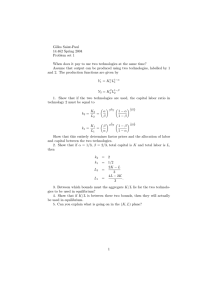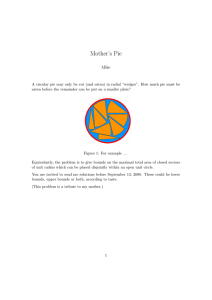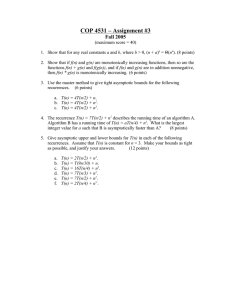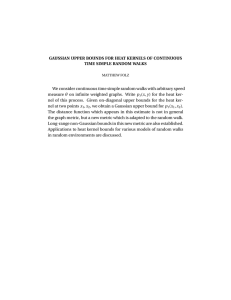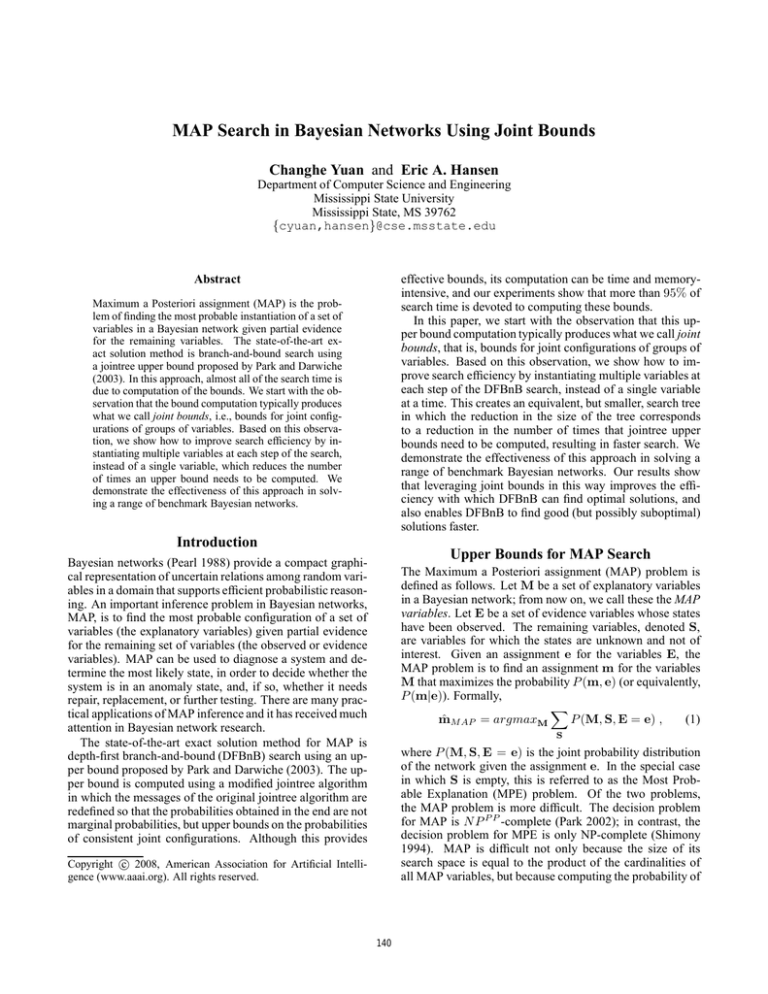
MAP Search in Bayesian Networks Using Joint Bounds
Changhe Yuan and Eric A. Hansen
Department of Computer Science and Engineering
Mississippi State University
Mississippi State, MS 39762
{cyuan,hansen}@cse.msstate.edu
effective bounds, its computation can be time and memoryintensive, and our experiments show that more than 95% of
search time is devoted to computing these bounds.
In this paper, we start with the observation that this upper bound computation typically produces what we call joint
bounds, that is, bounds for joint configurations of groups of
variables. Based on this observation, we show how to improve search efficiency by instantiating multiple variables at
each step of the DFBnB search, instead of a single variable
at a time. This creates an equivalent, but smaller, search tree
in which the reduction in the size of the tree corresponds
to a reduction in the number of times that jointree upper
bounds need to be computed, resulting in faster search. We
demonstrate the effectiveness of this approach in solving a
range of benchmark Bayesian networks. Our results show
that leveraging joint bounds in this way improves the efficiency with which DFBnB can find optimal solutions, and
also enables DFBnB to find good (but possibly suboptimal)
solutions faster.
Abstract
Maximum a Posteriori assignment (MAP) is the problem of finding the most probable instantiation of a set of
variables in a Bayesian network given partial evidence
for the remaining variables. The state-of-the-art exact solution method is branch-and-bound search using
a jointree upper bound proposed by Park and Darwiche
(2003). In this approach, almost all of the search time is
due to computation of the bounds. We start with the observation that the bound computation typically produces
what we call joint bounds, i.e., bounds for joint configurations of groups of variables. Based on this observation, we show how to improve search efficiency by instantiating multiple variables at each step of the search,
instead of a single variable, which reduces the number
of times an upper bound needs to be computed. We
demonstrate the effectiveness of this approach in solving a range of benchmark Bayesian networks.
Introduction
Upper Bounds for MAP Search
Bayesian networks (Pearl 1988) provide a compact graphical representation of uncertain relations among random variables in a domain that supports efficient probabilistic reasoning. An important inference problem in Bayesian networks,
MAP, is to find the most probable configuration of a set of
variables (the explanatory variables) given partial evidence
for the remaining set of variables (the observed or evidence
variables). MAP can be used to diagnose a system and determine the most likely state, in order to decide whether the
system is in an anomaly state, and, if so, whether it needs
repair, replacement, or further testing. There are many practical applications of MAP inference and it has received much
attention in Bayesian network research.
The state-of-the-art exact solution method for MAP is
depth-first branch-and-bound (DFBnB) search using an upper bound proposed by Park and Darwiche (2003). The upper bound is computed using a modified jointree algorithm
in which the messages of the original jointree algorithm are
redefined so that the probabilities obtained in the end are not
marginal probabilities, but upper bounds on the probabilities
of consistent joint configurations. Although this provides
The Maximum a Posteriori assignment (MAP) problem is
defined as follows. Let M be a set of explanatory variables
in a Bayesian network; from now on, we call these the MAP
variables. Let E be a set of evidence variables whose states
have been observed. The remaining variables, denoted S,
are variables for which the states are unknown and not of
interest. Given an assignment e for the variables E, the
MAP problem is to find an assignment m for the variables
M that maximizes the probability P (m, e) (or equivalently,
P (m|e)). Formally,
X
m̂MAP = argmaxM
P (M, S, E = e) ,
(1)
S
where P (M, S, E = e) is the joint probability distribution
of the network given the assignment e. In the special case
in which S is empty, this is referred to as the Most Probable Explanation (MPE) problem. Of the two problems,
the MAP problem is more difficult. The decision problem
for MAP is N P P P -complete (Park 2002); in contrast, the
decision problem for MPE is only NP-complete (Shimony
1994). MAP is difficult not only because the size of its
search space is equal to the product of the cardinalities of
all MAP variables, but because computing the probability of
c 2008, American Association for Artificial IntelliCopyright gence (www.aaai.org). All rights reserved.
140
Another approach to computing upper bounds for MAP is
mini-bucket elimination (Dechter & Rish 2003). It attempts
to use variable elimination to solve the original MAP problem, but if an elimination operation generates a potential that
is too large, it generates a set of smaller potentials that approximate the large potential. Experimental results show
that mini-bucket upper bounds are much looser than jointree upper bounds (Park & Darwiche 2003). Moreover, the
mini-bucket method does not produce simultaneous bounds
for multiple variables, and thus it does not allow dynamic
ordering when instantiating variables. Finally, mini-bucket
upper bounds are not joint bounds, as defined in the following section.
any instantiation of the MAP variables is PP-complete (Roth
1996).
We can rewrite P (M, S, E = e) as the product of the
conditional probability distributions in a Bayesian network,
using the so-called chain rule (Pearl 1988). In Equation (1),
note that the maximization and summation operators are applied to different sets of variables. The MAP variables in M
can be maximized in different orders, and the variables in
S can be summed out in different orders. The summations
and maximizations are not commutable, however. All summations have to be done before any maximization can be
carried out; violating this restriction produces incorrect solutions. In fact, we have the following theorem (Park 2002).
Theorem 1 Let φ(M, S, Z) be a potential over disjoint
variable sets M, S, and Z. For any instantiation z of Z,
the following inequality holds:
X
X
maxM φ(M, S, Z = z) ≥ maxM
φ(M, S, Z = z) .
S
Joint Bounds
The central observation of this paper is that the jointree
or clustering method for computing upper bounds on MAP
probabilities, described above, has a property that can be
leveraged to improve search efficiency. We begin with the
following definition.
Definition 1 In a MAP problem, a potential φ(X) is a joint
bound for X if, for any instantiation x of X, the following
inequality holds
X
φ(x) ≥ max
P (M − X, x, S, E = e).
S
Theorem 1 tells us that if we relax the orderings among
the summations and maximizations, we obtain upper-bound
probabilities. Park and Darwiche’s (2003) technique for
computing upper bounds is thus an example of the general
approach to computing bounds by finding exact solutions of
a relaxed version of a problem. Their specific technique uses
the jointree or clustering algorithm (Lauritzen & Spiegelhalter 1988) to build a secondary structure called a clique
tree and performs inference on the tree by message passing. The clique tree provides a systematic way of commuting the summations and maximizations in a MAP problem.
Their message-passing scheme is mostly the same as in the
original jointree algorithm, except the individual messages
are redefined. For any cluster i, the message λij sent from
cluster i to another cluster j is defined as summing out Y
followed by maximizing X from the potential of cluster i,
where X ∈ M and Y ∈ S are variables that appear in cluster i but not in cluster j. After message passing on the clique
tree is complete, for any cluster with maximization variables
X ∈ M and summation variables Y ∈ S, summing out Y
followed by maximizing X produces an upper bound on the
probability of the MAP solution. Furthermore, for any variable Xi ∈ X, summing out Y and maximizing X − {Xi }
produces upper bounds for all values of Xi .
Park and Darwiche use these upper bounds in a DFBnB
search to solve the MAP problem. The nodes of the search
tree represent partial instantiations of the MAP variables M.
The root node corresponds to the empty instantiation, and
the leaves correspond to different complete instantiations
of the MAP variables. For each internal node of the tree,
its successor nodes are determined by instantiating a single variable that had not previously been instantiated, and
there is one successor node for each possible value of that
variable. Because the clustering algorithm computes upper
bounds for all MAP variables simultaneously, dynamic ordering can be used in selecting the next MAP variable to instantiate. Park and Darwiche select the variable whose states
have the most asymmetric bounds.
M−X
S
At the end of message passing, each cluster on the clique
tree contains a potential ψ over its maximization variables
X ∈ M and summation variables Y ∈ S. More importantly,
the potential has already factored in the cluster’s original potential and all incoming messages. Now, if we only sum out
the variables in Y, we get a potential φ over X. We have the
following theorem for potential φ.
Theorem 2 When message passing is over, for each cluster
on the clique tree with final potential ψ over maximization
variables X ∈ M and summation variables Y ∈ S, the
following potential is a joint bound for X:
X
φ(X) =
ψ.
(2)
Y
Proof: Without loss of generality, let us focus on the root
cluster (a clique tree can be rearranged by using any cluster as the root). In computing the root potential, messages
are computed starting from the leaves of the tree and passed
through all the other clusters until reaching the root. This is
equivalent to recursively shifting maximizations inside summations. In particular, the root cluster provides a way to
shift the maximizations over M − X inside the summations
over Y and generate upper bounds. By simple induction,
M − X can be further mixed with S − Y according to the
clique tree to relax the bounds further. According to Theorem 1, after summing out Y, the potential φ(X) provides
upper bounds for all the configurations of X.
If we continue to maximize variables from φ, we get upper bounds for individual variables, which we call individual
bounds to distinguish them from joint bounds. These are the
bounds used in the DFBnB algorithm of Park and Darwiche.
However, no further maximization is necessary. As we show
below, the joint bounds can be directly used in MAP search.
141
very time (and memory) intensive, and the larger the clique
tree, the more expensive it is. Joint bounds make it possible
to reduce this overhead. For example, in order to expand the
search trees in Figure 1, we need to compute bounds once
for each internal node, which means 7 times in (a), 5 times
in (b), and only once in (c). Moreover, computing the joint
bounds for the 8 successors of the root node in Figure 1(c)
is no more expensive – in fact, it is less expensive – than
computing the individual bounds for the 2 successors of the
the root node in Figure 1(a), because individual bounds are
derived from joint bounds.
In fact, if we expand the search tree using a static ordering, we have the following theoretical result:
∅
a
A
ab
abc
aB
abC
aBc
Ab
Abc
aBC
AB
AbC
ABc
ABC
(a)
∅
ab
abc
aB
abC
aBc
Ab
aBC
AB
Abc
AbC
ABc
ABC
Abc
AbC
ABc
ABC
Theorem 3 If a static ordering is used in expanding a
search tree, using joint bounds will generate no more nodes
than using individual bounds.
Proof: First, note that as a search tree goes deeper, upper bound values are monotonically nonincreasing. This
is true because instead of maximizing or summing over a
variable, we fix the variable to a particular value. Furthermore, the heuristic values are the same for the same
node in both search trees using joint bounds and individual
bounds, because the same evidence has been instantiated for
the node. Given these results, we can show that a node N
expanded in the joint-bound search tree must be expanded
by the individual-bound tree. If not, there must be an ancestor M of N that is pruned in the individual-bound tree.
Let the probability of the current best solution be fM at the
moment of pruning. Since a fixed ordering is used, the same
set of potential solutions must have been visited or pruned.
Therefore, fN = fM > hM . However, since hM ≥ hN , we
have f > hN , which contradicts the assumption that N is
not pruned in the joint-bound search tree.
(b)
∅
abc
abC
aBc
aBC
(c)
Figure 1: Search trees for a three-binary-variable MAP
problem (a) full search tree instantiate one variable at a
time, (b) search tree utilizing two-variable joint heuristic,
(c) search tree utilizing three-variable joint heuristic.
MAP Search Using Joint Bounds
To leverage joint bounds to improve the efficiency of MAP
search, we only need to make a simple change to the function that generates the successors of a node in the search tree.
Using individual bounds, the successor function instantiates
one variable at a time. To leverage joint bounds, we modify the successor function so that it can instantiate multiple
variables at a time.
To illustrate the difference, we use a three-binary-variable
MAP problem with fixed variable ordering; later, we discuss
how to use dynamic variable ordering. Figure 1 shows the
search trees that are generated when different joint bounds
are available. When only individual bounds are available,
one variable is instantiated at a time and the search tree
shown in Figure 1(a) is generated. If joint bounds over the
variables A and B are available, these two variables can be
instantiated at the same time when generating the successors of the root node. The result is the search tree shown in
Figure 1(b). When joint bounds over all three variables are
available, the search tree shown in Figure 1(c) is generated.
By allowing multiple variables to be instantiated at the
same time when generating the successors of a node, joint
bounds allow substantial reduction in the time spent computing bounds. Before the successors of a node are generated,
the clique tree has to be reinitialized with correct values for
evidence and instantiated variables, and with correct potentials for all the clusters, and inference needs to be performed
on the clique tree, in order to compute the bounds. This is
With dynamic ordering, we cannot similarly guarantee
that use of joint bounds will not make the search less efficient. Using joint bounds, and instantiating multiple variables at a time, some nodes may be generated that would
not have been generated if the search algorithm instantiated
a single variable at a time and applied bounds earlier. However, experiments show that this adds little or no overhead to
DFBnB search. Moreover, there is also a potential advantage
in using joint bounds and instantiating multiple variables at
a time. DFBnB uses the bounds of the successor nodes to
choose which subtree to explore next, and a poor choice can
significantly slow the search. By selecting the subtree based
on the joint bounds after instantiating multiple variables, instead of the individual bounds after instantiating a single
variable, DFBnB can select the best subtree to explore based
on additional information, and this can improve search efficiency. Therefore, there is a tradeoff between the advantage
of taking larger steps in expanding the search tree versus the
advantage of generating intermediate search nodes to guide
dynamic ordering.
Dynamic Variable Ordering Using joint bounds, it is still
possible to dynamically choose which variable(s) to instantiate next. We use the following heuristics to make this choice.
First, we prefer to use joint bounds when they are available.
142
of root nodes (which is shown in parentheses). Again, we
used all leaf variables as evidence. Because there are not
many MAP variables in these cases, fewer joint bounds are
available, and yet using joint bounds still improves search
efficiency for some of the networks. However, we do notice
that for the Pigs network, the search is slightly slower using
the joint bounds. This reflects the potential drawback that
we discussed previously: joint bounds may generate more
nodes.
In the second experiment, we used all the root nodes as
MAP variables. Since this prevented the problems from being solved within the time limit, the third group of results
in Table 1 only reports the average time the algorithms took
to find the best solution. The results show that using joint
bounds allows DFBnB to find the best solution faster. Figure 2 shows two typical test cases for the Mildew network.
In the first, using individual bounds almost keeps pace with
using joint bounds at first, but the best solution is found
much sooner using joint bounds. Because both algorithms
found the same best solution long before running out of time,
we suspect that most of their search time is spent in trying to
prove the optimality of the solution. The difference is more
dramatic in the second case. DFBnB using joint bounds
found the best solution after only 40 seconds, whereas DFBnB using individual bounds did not find the same solution
until after 200 seconds. Similar results were obtained for
the other four networks, although the first solution found for
these networks was often the best ever found.
If more than one is avaiable, we choose the one that is most
asymmetric according to (Park & Darwiche 2003). If BV
is the best upper bound obtained for a configuration of variables V , and TV is the sum of bounds that are better than the
best solution found so far, we choose the joint bound that
maximizes the ratio BV /TV . Note that we do not always favor joint bounds with more variables, due to the tradeoff discussed previously. When only individual bounds are available, we use the same criterion to choose a single variable to
instantiate.
Experimental Results
Table 1 compares the performance of DFBnB search using
individual and joint bounds in solving a range of benchmark Bayesian networks. For each network, we generated
50 random test cases with all root nodes as MAP variables
and all leaf nodes as evidence variables. For each test case,
the states for the evidence variables were randomly selected
(making sure that their joint probability was non-zero). The
experiments were performed on a 3.2GHz processor with
3.25G RAM.
Solved Test Cases
The first group of results in Table 1 are for the test cases
that could be solved exactly within the time limit. These results show that network size alone is not a reliable predictor
of problem difficulty. Munin4 and CPCS360 are large networks with hundreds of variables, but their MAP problems
are relatively easy to solve. The reason, we believe, is that
these networks have a simple, layered structure. By contrast, Barley and Mildew are small networks, but their MAP
problems are very hard to solve. Among the reasons they
are difficult to solve, Barley has one node with 67 states,
and Mildew has very little asymmetry in its CPTs, and both
factors contribute to a very large search space.
The results show that using joint instead of individual
bounds significantly improves the search efficiency of DFBnB, especially in solving CPCS179, CPCS360, Hailfinder,
Munin4, and Water. In some cases, it makes DFBnB several times faster. In addition, it helps DFBnB find the best
solution faster. This is useful for problems that are too difficult to solve exactly. Finally, the results for Hailfinder show
the best solution is often found very early in the search, and
most search time is spent proving the optimality of the solution.
Effect of Number of MAP Variables
The number of MAP variables affects the number of joint
bounds that are available. If there are very few MAP variables, a clique tree may only have individual bounds. The
number of joint bounds increases with the number of MAP
variables. Figure 3 shows the effect of the number of MAP
variables on the relative benefit of using joint bounds in solv-
6
Running Time Ratio
5
Results for difficult networks
For several of the benchmark Bayesian networks, including
Andes, Barley, Diabetes, Mildew, and Pigs, the test cases
could not be solved exactly within a time limit of 40 minutes.
For these networks, we report results for two experiments.
For each network in the experiments, we generated 10 test
cases.
In the first experiment, we used as many MAP variables
as possible while still allowing the test cases to be solved
within the time limit. The results are presented in the second group in Table 1. The third column shows the actual
number of MAP variables selected from the total number
4
3
2
1
0
1
3
5
7
9
11
13
15
17
19
21
23
25
Number of MAP Variables
Figure 3: Ratio of the running time of DFBnB using individual bounds to the running time of DFBnB using joint bounds
in solving the MAP problem for the Munin4 network, as a
function of the number of MAP/evidence variables.
143
Insurance
Carpo
Plarge10
Alarm
Hepar II
Win95pts
BN78
BN79
CPCS179
CPCS360
Water
Hailfinder
Munin4
BN0
BN10
Barley
Diabetes
Mildew
Pigs
Andes
Barley
Diabetes
Mildew
Pigs
Andes
Domain characteristics
total variables MAP variables average BF
27
2
2.2
61
15
2
50
4
25
37
12
2.2
70
9
2.2
76
34
2
54
13
2
54
13
2
179
12
2.1
360
25
2
32
8
3.6
56
17
3.8
1041
259
4.3
100
13
2
85
15
2
48
5(10)
12.4
413
10(76)
13
35
10(16)
4.4
441
80(145)
3
223
25(89)
2
48
10
12.4
413
76
13
35
16
4.4
441
145
3
223
89
2
Total Time
individual
joint
2
2
4
3
3
3
2
1
4
4
10
3
54
47
62
46
99
29
957
14
1,241
180
10,142
7,365
23,153
4,096
113,549
78,535
131,249
46,436
123,499 112,239
272,224 272,184
361,491 353,936
458,120 495,381
573,131 470,838
-
Solution Time
individual
joint
<1
<1
<1
<1
<1
<1
2
<1
1
1
8
2
39
23
31
23
96
26
953
11
1,230
175
142
98
23,150
4,096
73,010
48,077
84,177
22,143
2,706
2,021
3,001
3,000
57,055
20,313
95
76
121,533
66,637
13,805
9,883
24,766
20,594
190,160
44,110
648
359
466,184 242,913
Table 1: Comparison of the average running times of DFBnB using individual and joint bounds in solving MAP problems
for benchmark Bayesian networks. Time is measured in milliseconds. In labeling the columns, ‘BF’ is an abbreviation for
branching factor; ‘total time’ is the time it takes the algorithm to converge to an exact solution; and ‘solution time’ is the time
it takes the algorithm to find what turns out to be the best solution.
7.10E-09
7.05E-09
7.05E-09
7.00E-09
Solution Probability
Solution Probability
7.04E-09
6.90E-09
6.80E-09
6.70E-09
7.04E-09
7.03E-09
7.03E-09
7.02E-09
individual
joint
6.60E-09
7.02E-09
6.50E-09
0
50
100
150
individual
joint
7.01E-09
200
0
Running Time (s)
50
100
150
200
Running Time (s)
(a)
(b)
Figure 2: Comparison of DFBnB using individual and joint bounds in finding the best solution for two test cases of the Mildew
network. (The horizontal line shows the best solution found.)
144
ing the Munin4 network. As the number of MAP/evidence
variables increases, the relative advantage of using joint
bounds also increases.
a range of benchmark Bayesian networks. Our results show
that leveraging joint bounds in this way not only improves
the efficiency with which DFBnB finds optimal solutions, it
also enables DFBnB to find good (but possibly suboptimal)
solutions faster.
Although our approach reduces the number of times upper
bounds need to be computed, computing the jointree upper
bound is still the bottleneck of the algorithm. Further improvement of search efficiency will require finding more efficient techniques for computing these bounds. We are also
interested in whether similar joint bounds can be exploited
for other search problems.
Related Work
Many algorithms have been proposed to solve the MAP
problem in Bayesian networks. We briefly review some of
them, beginning with two exact algorithms.
DFBnB using jointree (clustering) upper bounds (Park
& Darwiche 2003): This work is the most closely related to
our own and has been discussed throughout this paper.
DFBnB using arithmetic circuit upper bounds (Huang,
Chavira, & Darwiche 2006): This work proposes a new
way to compute upper bounds for MAP by compiling
Bayesian networks into arithmetic circuits (Chavira & Darwiche 2005). It is designed for Bayesian networks that have
a lot of local structure, and may not be effective for other
networks. Currently, it requires DFBnB to use fixed variable ordering.
These exact algorithms are most effective for finding optimal solutions in small to medium-sized networks, or networks with a lot of local structure. DFBnB can also be applied to more difficult MAP problems that cannot be solved
exactly, since DFBnB often finds good solutions quickly
and can be stopped before convergence. Other approximate
search algorithms for difficult MAP problems include the
following.
Local Search (Park & Darwiche 2001): Hill climbing
has been shown to be effective in finding approximate solutions to MAP problems, and often finds optimal or closeto-optimal solutions, although it does not provide any guarantee of the quality of a solution. Tabu search makes the
local search even more effective.
Genetic Algorithm (de Campos, Gamez, & Moral 1999):
This work uses the junction tree algorithm as an evaluation
function in a genetic algorithm that solves MAP problems.
Annealed MAP (Yuan, Lu, & Druzdzel 2004): This algorithm applies Markov Chain Monte Carlo methods (Geman & Geman 1984) and simulated annealing (Kirkpatrick,
Gelatt, & Vecchi 1983) to solve MAP problems. It has been
shown to be effective on large Bayesian networks.
DWA* (Sun, Druzdzel, & Yuan 2007): Since hill climbing often produces surprisingly good solutions, this algorithm solves MAP problems using A* search guided by a
dynamically weighted greedy heuristic. Although the algorithm is not guaranteed to find an optimal solution, it was
shown to be effective on many Bayesian networks.
Acknowledgements
We thank the anonymous reviewers for their insightful comments that have led to improvements in the paper. All experimental data have been obtained using SMILE, a Bayesian
inference engine developed at the Decision Systems Laboratory and available at http://genie.sis.pitt.edu.
References
Chavira, M., and Darwiche, A. 2005. Compiling bayesian
networks with local structure. In Proceedings of the 19th
International Joint Conference on Artificial Intelligence
(IJCAI-05), 1306 1312.
de Campos, L. M.; Gamez, J. A.; and Moral, S. 1999.
Partial abductive inference in bayesian belief networks
using a genetic algorithm. Pattern Recognition Letters
20:12111217.
Dechter, R., and Rish, I. 2003. Mini-buckets: A general scheme for approximating inference. Journal of ACM
50(2):1–61.
Geman, S., and Geman, D. 1984. Stochastic relaxations,
Gibbs distributions and the Bayesian restoration of images.
IEEE Transactions on Pattern Analysis and Machine Intelligence 6(6):721–742.
Huang, J.; Chavira, M.; and Darwiche, A. 2006. Solving
map exactly by searching on compiled arithmetic circuits.
In Proceedings of the 21st National Conference on Artificial Intelligence (AAAI-06), 143148.
Kirkpatrick, S.; Gelatt, C. D.; and Vecchi, M. P. 1983.
Optimization by simulated annealing. Science (4598):671–
680.
Lauritzen, S. L., and Spiegelhalter, D. J. 1988. Local
computations with probabilities on graphical structures and
their application to expert systems. Journal of the Royal
Statistical Society, Series B (Methodological) 50(2):157–
224.
Park, J. D., and Darwiche, A. 2001. Approximating MAP
using local search. In Proceedings of the 17th Conference
on Uncertainty in Artificial Intelligence (UAI–01), 403–
410.
Park, J. D., and Darwiche, A. 2003. Solving MAP exactly
using systematic search. In Proceedings of the 19th Conference on Uncertainty in Artificial Intelligence (UAI–03),
459–468.
Conclusion
The central observation of this paper is that the jointree
(or clustering) upper bound proposed in (Park & Darwiche
2003) for the MAP problem produces joint bounds for
groups of variables. We showed how to use these joint
bounds to significantly improve the efficiency of a depthfirst branch-and-bound search algorithm for solving the
MAP problem. The improvement of search efficiency is due
to a reduction in the number of times that upper bounds need
to be computed, and we demonstrated the improvement on
145
Park, J. D. 2002. MAP complexity results and approximation methods. In Proceedings of the 18th Conference on
Uncertainty in Artificial Intelligence (UAI–02), 388–396.
Pearl, J. 1988. Probabilistic Reasoning in Intelligent Systems: Networks of Plausible Inference. San Mateo, CA:
Morgan Kaufmann Publishers, Inc.
Roth, D. 1996. On the hardness of approximate reasoning.
Artificial Intelligence 82(1-2):273–302.
Shimony, S. E. 1994. Finding MAPs for belief networks is
NP-hard. Artificial Intelligence 68:399–410.
Sun, X.; Druzdzel, M. J.; and Yuan, C. 2007. Dynamic
weighting A∗ search-based MAP algorithm for Bayesian
networks. In Proceedings of the International Joint Conference on Artificial Intelligence (IJCAI-07), 2385–2390.
Yuan, C.; Lu, T.; and Druzdzel, M. J. 2004. Annealed
MAP. In Proceedings of the 20th Annual Conference on
Uncertainty in Artificial Intelligence (UAI–04), 628–635.
146


